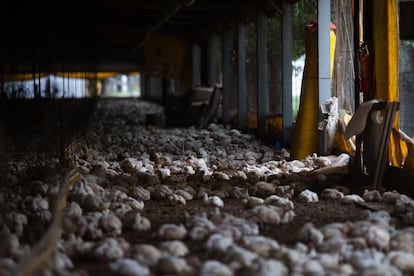Argentina suspends poultry exports after first case of industrial bird flu
The country has been on a health alert for nearly two weeks after detecting infections among wild birds and backyard fowl


After two weeks of extreme surveillance, Argentina’s health authorities have detected the first case of a bird infected with bird flu on an industrial farm. The National Agri-Food Health and Quality Service (Senasa) has confirmed the infection in a broiler farm in the province of Río Negro, in northern Patagonia. The announcement automatically cancels exports of poultry products in the country, confirming the Economy Ministry’s greatest fear, as exports represent more than $350 million a year.
The government had activated health alerts after detecting eight cases in wild birds. The Economy Ministry then announced financial support for producers fearing that the difficulties experienced by rural sectors due to droughts would lead to underreporting of suspected cases. Senasa has analyzed 177 cases to Tuesday, and has confirmed 25 infections, 21 of them in backyard birds.
Authorities said that domestic consumption “will continue normally” since the disease cannot be transmitted by eating meat or eggs. “Our poultry products continue to be safe for Argentines. The suspension of exports responds to the requirements of international regulations,” the Secretary of Agriculture, Juan José Bahillo, said on Twitter.
The government had reinforced sanitary controls at border crossings and had intensified searches in natural areas where wild birds congregate, but the biggest concern was that the disease would end up breaking out on industrial farms. Argentina ranks eighth in the world for highest poultry production, according to the latest annual report from the Ministry of Agriculture. According to government data, 97% of its production is for domestic consumption and the remaining 3% is exported to more than 56 countries.
Poultry production involves more than 100 small and medium-sized companies and employs almost 70,000 people throughout the country. The situation is complicated on all fronts: the sectors that produce food are going through the worst droughts in decades and the government needs the dollars from exports to curb inflation that is close to 100% year-on-year.
Bird flu is spreading across South America. In Bolivia, whose border with northern Argentina is very active, the virus was detected in early February and more than 140,000 birds have already been slaughtered on industrial farms. Uruguay, Paraguay and Brazil are also on alert. Peru and Chile have recorded deaths of sea lions that apparently contracted the virus by eating infected bird carcasses. Researchers fear that the mass deaths mean the virus may start to spread between mammals.
Whether the disease can mutate and spread between people is a concern in the scientific community because humans have no defenses against this virus. Since 2003, some 870 human cases have been reported and more than half have died. The latest case was an 11-year-old girl who died in Cambodia in an area where it is common to live with poultry.
Sign up for our weekly newsletter to get more English-language news coverage from EL PAÍS USA Edition
Tu suscripción se está usando en otro dispositivo
¿Quieres añadir otro usuario a tu suscripción?
Si continúas leyendo en este dispositivo, no se podrá leer en el otro.
FlechaTu suscripción se está usando en otro dispositivo y solo puedes acceder a EL PAÍS desde un dispositivo a la vez.
Si quieres compartir tu cuenta, cambia tu suscripción a la modalidad Premium, así podrás añadir otro usuario. Cada uno accederá con su propia cuenta de email, lo que os permitirá personalizar vuestra experiencia en EL PAÍS.
¿Tienes una suscripción de empresa? Accede aquí para contratar más cuentas.
En el caso de no saber quién está usando tu cuenta, te recomendamos cambiar tu contraseña aquí.
Si decides continuar compartiendo tu cuenta, este mensaje se mostrará en tu dispositivo y en el de la otra persona que está usando tu cuenta de forma indefinida, afectando a tu experiencia de lectura. Puedes consultar aquí los términos y condiciones de la suscripción digital.
More information
Archived In
Últimas noticias
Most viewed
- Sinaloa Cartel war is taking its toll on Los Chapitos
- Oona Chaplin: ‘I told James Cameron that I was living in a treehouse and starting a permaculture project with a friend’
- Reinhard Genzel, Nobel laureate in physics: ‘One-minute videos will never give you the truth’
- Why the price of coffee has skyrocketed: from Brazilian plantations to specialty coffee houses
- Silver prices are going crazy: This is what’s fueling the rally










































